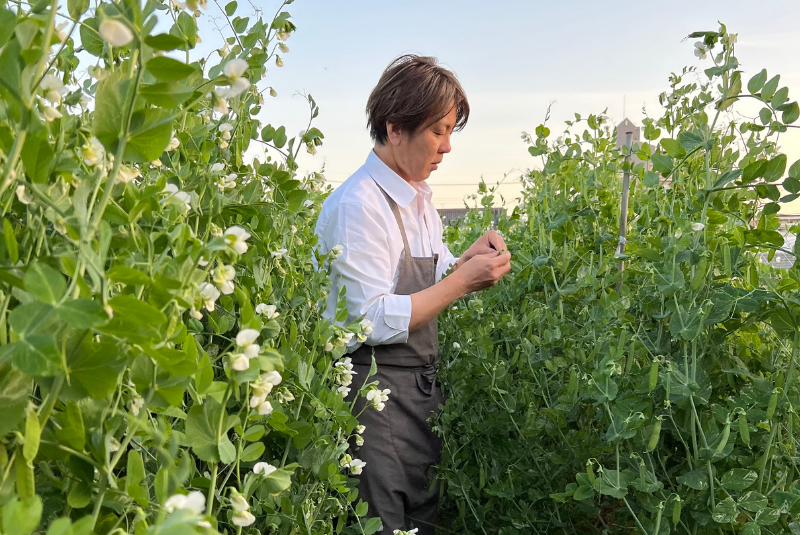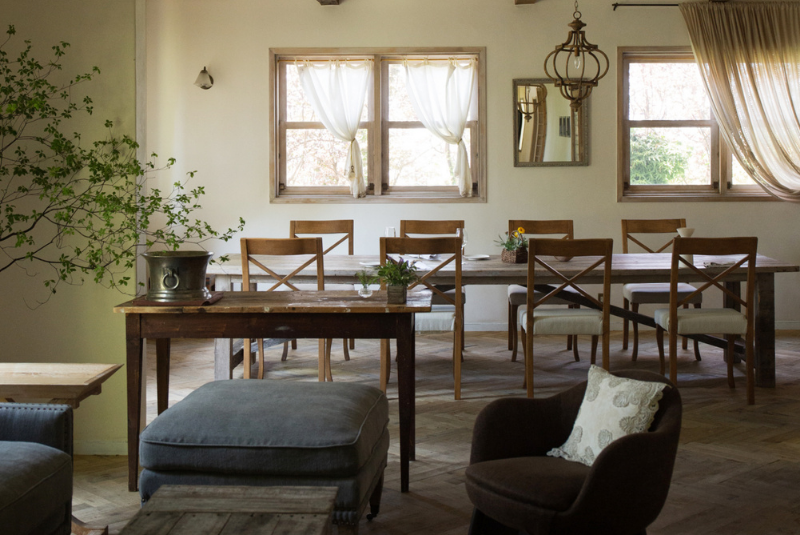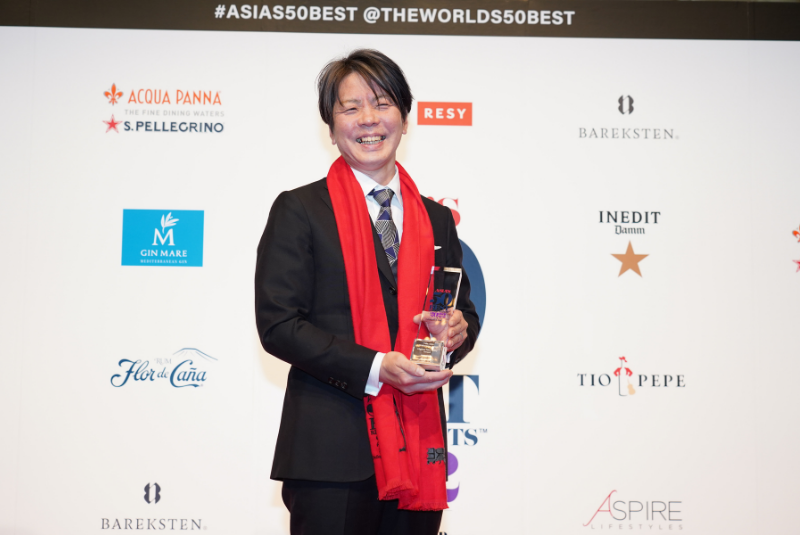It’s one thing to come roaring onto the Asia’s 50 Best Restaurants list, grabbing the Highest New Entry Award 2022, sponsored by Aspire Lifestyles, but quite another to do it with Villa Aida’s bare statistics. Number of tables: one; services per day: one; kitchen personnel: one; front of house personnel: one; kilometres from Osaka, the nearest major city: 75. Nick Coldicott travels to Iwade in rural Wakayama, Japan, to discover how the restaurant does it
Kanji Kobayashi plucks a tiny bud from the mandarin tree that stands just outside his restaurant, pops it in his mouth, and likes what he’s tasting.
“I think I’ll use these tomorrow,” he says. He hasn’t decided how, but he thinks they might work nicely with the caviar-sized baby broad beans his wife Yumi, the restaurant’s sommelier and the only other person to work there, has been shucking that afternoon.
Villa Aida is surely the only restaurant in the world that can – and would – combine the two. “You can’t really ask farmers to harvest so early,” says Kanji. But when you are the farmer and you have land the size of 27 tennis courts to play with, you don’t have to follow the rules.
He strolls his fields plucking flowers, leaves, buds, pulling up roots, foraging for inspiration. Where people see one ingredient, he sees two, three or four. Fig trees bear figs, sure, but they also have leaves that can flavour an ice cream. Fennel has a bulb, root, flowers and seeds, and he uses all of it. He grows ten varieties of carrot and harvests some when tiny, some when fully grown, and leaves some in the fields to flower. “Most people don’t even know carrots grow flowers,” he says.

Chef Kanji Kobayashi foraging in his fields (image: Hu Jia Jiong)
Kanji holds a sprig of white petals so tiny and fragile they look hardly worth eating. They turn out to pack the striking, unmistakable tang of daikon radish. Few farmers let their vegetables reach the point of flowering, so few chefs get to play with ingredients like this. But here at Villa Aida, this two-person team can – and, adds Yumi, “we never have to think about the cost”.
When you dine at Villa Aida, a tour of the farm is part of the experience. “Our guests usually pick something from the fields to taste,” says Yumi, presenting a pod of impossibly sweet peas as an example. “Last week we had a chef friend take a bottle of champagne and some glasses out to drink as he tried some beans.” Some of their closest chef friends have asked to use the produce from Villa Aida’s farm. Both Florilège (No.3 on Asia’s 50 Best Restaurants 2022) and Ode (No.13) get regular deliveries, so technically the Kobayashis have a hand in three of the restaurants on the list this year.
It wasn’t always like this, though. Back in 1998 when he first opened the restaurant, Kanji was an eager 25-year-old who had just returned from four years working in kitchens up and down Italy. He built a restaurant on a rice field his family owned and began replicating what he had learned in Europe.
“At first it went well,” he says. “Many locals came to see what it was about.” But they rarely came twice. This was Iwade, population 50,000, where the other dining options included okonomiyaki (savoury pancake) hole-in-the-walls and a 70-seat ramen joint. Smartphones and social media had not been invented yet, so reaching the gastro-hunters in the big cities was a challenge. “After the initial success, it got really difficult,” he says. 
The secluded restaurant is located in rural Wakayama, one hour south of Osaka
Eventually he realized that it wasn’t the recipes he needed to import from Italy but the philosophy. Specifically, the idea of campanilismo: cooking with ingredients that can be found within hearing distance of the local church bells. “[In Italy] I was surprised that the local chef used lemon leaves when he made custard,” he says. “That chef told me: ‘We don’t use vanilla because it’s expensive and we don’t get it here.’ I was impressed by how delicious the custard was and how well it matched the Italian climate and ingredients.”
And Kanji was perfectly positioned to produce his own style of campanilismo. His father, a fireman by profession, was also a passionate amateur farmer. But as a young boy, the chef had no interest at all in growing food. “I helped out a bit, but it wasn’t what I wanted to do,” he says.
His father’s fields are now what sets Villa Aida apart. Though he buys in local game and fish, and gets a sprinkling of ingredients – salt, olive oil, ginger, flour, cheese – from further away, the core of a Villa Aida meal comes from almost arm’s reach of the stove. “Sometimes you can see him dart out of the kitchen during service to pick an ingredient,” says Yumi.
The chef can’t send anyone else because there is nobody else. In the early days he worked in a team of three, but he found it hard to manage. “I want to make what I want to make, and I’m not so good at conveying my ideas,” he says. “People don’t always get 100 per cent of what I’m asking.” That is partly because he speaks sparsely in almost a whisper, but also because he doesn’t have any formal recipes. Every day is different.
The process often begins with Yumi, who joined the restaurant in 2007 in part, she says, because he didn’t have anyone to run front-of-house and she thought she ought to help. She is the first one on the farm, shortly after dawn, and does much of the harvesting, either working to order from the chef or picking whatever catches her eye. “Sometimes I completely forget I planted something, and then suddenly I spot it,” she laughs. 
Villa Aida was given the Highest New Entry Award 2022, sponsored by Aspire Lifestyles, at an in-person ceremony in Tokyo for Asia's 50 Best Restaurants
Yumi knew nothing of farming when she gave up her bistro in Osaka and moved to Iwade. “I did a lot of research on the internet and asked my farmer friends. Even now, if I have some problem with the farm I go to them,” she says. The only fertilizer she uses is vinegar and the only form of pest control are sachets of “something organic – I’m not sure if they work” hanging in some of the grow-houses. Kanji says he does not mind if bugs eat the crops; he can work with whatever they leave him.
Service takes place just once a day and there is only one table. Kanji says they downsized three years ago so he could focus on executing his vision, which he calls “agro-gastronomy”, without worrying about the supply of produce. When service is done, Kanji usually stays in the kitchen working on ideas for the next day’s guests.
The dining experience is an intimate one, with husband-and-wife hosting in what looks more like a living room than a restaurant. It brings to mind the old trope about feeling as though you’re dining in somebody’s home. “Yes, people say it feels like that,” says Yumi. “But actually it is that. We live upstairs.”
It has been a long road, but Iwade is now a gastronomic destination and people travel the country for the restaurant that is not so much farm-to-table as a table on a farm. When asked at what point, in the past 24 years, did Kanji realise that his vision was working, he thinks for a moment and says quietly, “Right now.”
The latest edition of Asia’s 50 Best Restaurants 2022, sponsored by S.Pellegrino & Acqua Panna, was announced on Tuesday 29th March at live ceremonies in Bangkok, Macau and Tokyo. Browse the website, join the community on Instagram, follow us on Facebook, visit us on Twitter and subscribe to our YouTube channel to stay up to date with the latest news and announcements.

